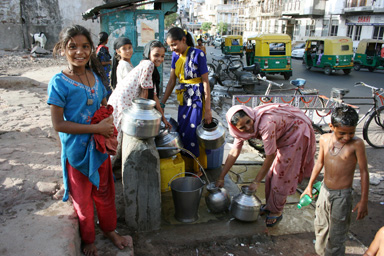Safe drinking water: Rural pockets in Maharashtra show the way
|

In Mandwa and Anji villages, approximately 100 kilometers from Nagpur (Maharashtra, India), several families have taken to two simple practices. One, fixing plastic taps to the earthen pots in which they store drinking water and/or adding a few drops of hypochlorite solution to stored water.
Says the Government Accredited Social Health Activist (ASHA) of Mandwa village, Rajni Harke, “Up to three years ago, it was a very common practice for women and children to scoop water from the pots with their hands. Today, most of the families here also put two drops of chlorine in the approximately 10 liters of the earthen pot and they are able to consume the same for the day.''
Although Maharashtra has access to safe drinking water at village level, high morbidity and mortality due to diarrhea in rural areas is still high. Dr. Pradeep Deshmukh, Professor at the Mahatma Gandhi Institute of Medical Sciences (MGIMS) points out that coliform (a type of bacteria) levels were considerably higher in household water containers than in the original source water.
Under the Community Led Initiatives for Child Survival (CLICS) program that was supported by USAID and Aga Khan Foundation, the village health committees (VHC) purchased plastic faucets and bottles of sodium hypochlorite solution from a wholesale market and made it available at subsidized rates at village level. The cost of fitting a plastic faucet to earthen vessel and that of a 50 ml hypochlorite solution (4-6%) bottle was fixed at Rs 15 each (around US 30¢).
The intervention was promoted through the network of village level community based organizations (CBOs) and village health workers (VHWs) were also trained in fitting faucets and teaching mothers regarding use of hypochlorite solution.
A follow-up study across 10 villages of Primary Health Centre, Anji looked at 144 households which used either faucet-fitted earthen vessel to store drinking water or used sodium hypochlorite solution (SH) for keeping drinking water safe and 213 neighborhood control households from the same locality who used neither of the methods, and found that by using these methods, the community would prevent about 22 per cent cases of diarrhea.
In Anji, Sumitra Rajendra Vasule and Sudha Suresh Dehare are very clear in their minds about the benefits of this intervention. “We understand that this helps us prevent episodes of gastroenteritis. I remember how difficult it was to look after my 80-year-old mother-in-law, when she had such an episode some years ago.”
Sudha says, “Now all household members know that they should not put their hands in the earthen vessel. Earlier, the summer seasons in these villages always had episodes of diarrhea. I would say 75 per cent of illnesses have come down because of being careful about our drinking water.”
--Sushmita Malaviya, communications officer in Delhi for PATH's Vaccine Development Program
For more information:
-- India makes strides in diarrhea treatment by adding zinc to oral rehydration therapy (ORT) kits.
-- Learn about PATH's Safe Water Project and their microfinance efforts in India.
Photo credit: PATH














